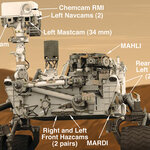Aerospace

The landing of a cute robot on Mars really resonated with American popular culture this past weekend; and so the first few images Curiosity snapped have caught fire as well, including a blotch that was no longer there in later pictures.
Curiosity landed at 10:32 p.m. Aug. 5 PDT near the foot of a mountain three miles tall inside Gale Crater, which is 96 miles in diameter. Curiosity is the largest mission ever sent to another planet. Its 9 month, 350 million mile journey ended with 'seven minutes of terror' and no one knew precisely where it would end up or when it would get down to…

Pyros small tactical munition completed a successful warhead and guidance system test, according to Raytheon.
There are three choices for guiding the weapon to the target: GPS coordinates, inertial navigation or laser designation. There are also three options for engaging the target: height-of-burst, point-of-impact or fuze-delay detonation. The end-to-end test validated the weapon's guidance modes (semi-active laser and global positioning system), its height-of-burst sensor, electronic safe and arm device, and multi-effects warhead.
During the test, Pyros was dropped from a…

Curiosity, the Mars Science Laboratory spacecraft, remains in good health and is just one day and 12 hours from touchdown on Mars. All systems are go and it is doing so well the planned Trajectory Correction Maneuver 5 (TCM-5) and its update to parameters for the autonomous entry, descent and landing will not be necessary. If it ain't broke, don't fix it, as they say.
As of noon yesterday the Mars Science Laboratory spacecraft was about 470,000 miles from Mars, a little less than twice the distance from Earth to the moon. It is traveling at about 8,000 mph and will gradually…

There are several schools of thought on building a CubeSat or other picosatellite. We will contrast what we call Lego-style with what we'll dub the Custom Shop approach.
Lego Style suggests using the easiest, rather than the most efficient, parts and tools to create your satellite. This is the kit-bashing or Lego bricks approach. You have several generic pieces, and you put them together to make what you want. The final end product may be a bit square and clunky, but the advantage is that you were able to quickly build and test.
The justification is time-based and…

NASA's Inflatable Reentry Vehicle Experiment (IRVE-3), a large inflatable heat shield developed, was launched by sounding rocket at 7:01 a.m. Monday from NASA's Wallops Flight Facility on Wallops Island, Va. It successfully survived a trip through Earth's atmosphere while traveling at hypersonic speeds of 7,600 mph.
The purpose of the IRVE-3 test was to show that a space capsule can use an inflatable outer shell to slow and protect itself as it enters an atmosphere at hypersonic speed during planetary entry and descent, or as it returns to Earth with cargo from the International Space…

The Very Large Array (VLA) radio astronomy observatory, named for American physicist Karl Guthe Jansky, who discovered radio waves emanating from the Milky Way in 1931, is the largest and most capable radio telescope in the world
In the 1980s, collaboration between the U.S. Naval Research Laboratory (NRL) and the National Radio Astronomy Observatory (NRAO) helped develop the 330 MHz Very Large Array system that has been widely and successfully used in astrophysics and ionospheric science. In the 1990s they developed and deployed a narrow band receiver system operating at 74 MHz, so called the…

On July 11, NASA scientists will launch into space the highest resolution solar telescope ever to observe the solar corona, the million degree outer solar atmosphere.
But it will only last 10 minutes.
During that ten-minute journey, the High Resolution Coronal Imager (called HI-C) will focus on the center of the sun, where a large sunspot is predicted to be – a prediction based on what the sun looked like 27 days previously, since it takes 27 days for the sun to complete a full rotation. HI-C will fly aboard a Black Brant sounding rocket to be launched from the White Sands Missile…

If you use off-the-shelf electronics parts instead of expensive, hard-to-find space-rated gear, will your satellite work? The process of 'derating' will let you do this. Engineer Amanda Shields contributes today's guest column.
I'm becoming very familiar with derating and the joys of it. Electrical components for spacecraft have to be derated. Basically, that means that you take the electrical component and you look at the data sheet for that piece and you have to say "Well, according to the datasheet it can have a maximum input power of XX, but NASA says that it has…

NASA's Voyager 1, launched in 1977, was propelled into deep space with the help of Jupiter's and Saturn's gravity. Now it is about to leave the solar system. But exactly when is unclear.
Voyager 1 is traveling at a speed of about 3.6 Astronomical Units (AU) per year - one 'AU' equals the distance between the Sun and the Earth, or 93 million miles.
The data making the 16-hour-38 minute, 11.1-billion-mile journey from Voyager 1 to antennas of NASA's Deep Space Network on Earth detail the number of charged particles measured by the two High Energy telescopes aboard the spacecraft. These…
A Mojave rocket company, an asteroid hunter, and a web pundit walk into a conference. The badge person says, "what is this some kind of joke?"
Okay, we gotta get to space somehow. Here's what's new in the private space race industry. What ties these 4 newsbits together is it's all about having fun.
SatMagazine (March 2012) reports
Interorbital Systems (IOS) of Mojave, California, entered 2012 armed with the notification of its selection for a NASA SBIR Phase I award supporting the continued development of the company’s NEPTUNE modular rocket system. The NEPTUNE family of…